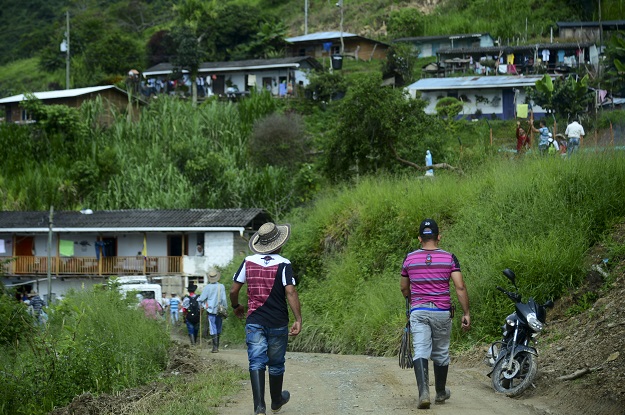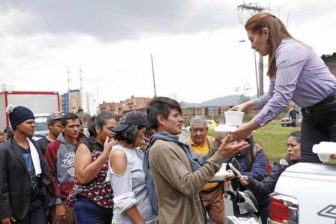At the heart of Colombia’s peace agreement with the FARC is an earnest effort to improve life in its long neglected countryside. A series of national programs for education, health, electrification, housing and credit for the agricultural sector, built into the agreement, are designed to help close a woeful development gap between urban centers and rural communities. These development needs in rural areas are immense. According to the 2014 National Agricultural Census, 57.2 percent of rural homes don’t have access to drinkable water and 94 percent of the population doesn’t have access to sewage systems. Seventy-three percent of youths between 17 and 24 in these areas don’t attend school, and poverty is as high as 45.7 percent, compared to 15.4 percent for urban centers.
In order to bridge this gap, the peace agreement includes measures to foster the peasant economy and support traditional and communitarian ways of farming. Through a planning tool known as the PDET (Rural Development Plans with Territorial Approach), Colombian policymakers hope to enable rural communities to make decisions about their economic future and to formalize land rights.
But not everyone is on board with such a focus. The deal’s opponents argue that such programs will present an obstacle to agro-industrial development, pose a risk to private entrepreneurship and limit the positive effect of the large-scale investment projects the country needs to keep its economic motor going. They have serious doubts about the nature of land redistribution, and mistrust state agricultural institutions tasked with improving economic opportunities for rural communities.
These two visions need not be mutually exclusive. Indeed, without first tending to the needs and priorities that rural communities have set for themselves, the large-scale economic development that national-level policymakers hope will come with peace is unlikely to materialize.
In the midst of this tension, Colombian public opinion and the national government have too often ignored and devalued the role that municipalities and city councils play in rural and territorial development. But, in fact, mayors and municipal councils are at the center of development. These municipal authorities are in charge of regulating and ordering land use, approving taxes, updating survey maps, building and maintaining tertiary roads, designing and implementing security policies and, in general, providing basic public goods. Central government plans must align with these local powers if any progress is to be made and sustained.
The lack of coordination between central authorities and local actors has generated serious difficulties. In fact, local actors have recently challenged the power of the national government to decide unilaterally on development. Colombia is now experiencing a wave of popular consultations that have shown the power of local groups to mobilize against mining and energy concerns. This type of mobilization has forced a debate as to who should benefit – and how – from natural resource extraction in the country (this in a country in which state revenues are highly dependent on hydrocarbon royalties and where oil and coal represent 47.7 percent of all export trade).
These consultations, and their backing from the Constitutional Court, have underlined the citizens’ right to participate in decisions concerning their future. National officials should accept that local rights are not inferior to the state’s need to generate income, and that this statement applies to mining as well as to land usage and rural development.
There are signs that this vision of development is starting to take hold. One example is in the municipality of Briceño, Antioquia, which is currently implementing two pilot projects on demining and illicit crops substitution. In 2015, there were 17 violent deaths in Briceño, equivalent to a murder rate of more than 190 per 100,000 when the national average is just above 24. There, Fundación Ideas para la Paz (FIP) is working to align political priorities at the municipal level with national-level development initiatives, under the belief that reconciling these two agendas is necessary for any development to be sustainable.
But there remains much to be done. For example, to address drug trafficking and the illicit drugs economy in Colombia, more productive opportunities are needed for the low-income population. To do that, rural development and illicit crop substitution policies have to be designed in collaboration with local communities and local authorities. Failing to understand local needs risks funneling resources in a manner that is counterproductive or generates unintended consequences. Again, there are tools available to make sure this occurs. One is the mayor’s peace office, an institutional mechanism created to coordinate national and local efforts on post-conflict. FIP has supported this effort, and through it we have understood that listening to different sectors within the community and achieving consensus means more than the technocratic reasoning delivered from above.
The roll-out of the peace process will depend on the cooperation between the national government, the FARC and local actors (municipalities and communities). Each constituent must be seen and heard as we collectively search for viable and competitive alternatives to coca in the larger context of the peace process.
Those who believe that implementing peace is a problem for the national government to solve are wrong. In order for peace to be a success, the efforts of national authorities must be accompanied by increased investment in local capacity building. To not do so would be throwing time and money down the drain.
—
Guarín is the Post-Conflict Program director for Fundación Ideas para la Paz.








